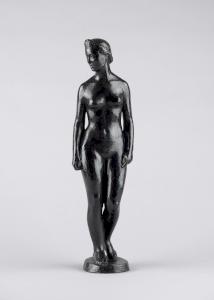Paul Cornet (1892-1977)
Paul Cornet was born on the eighteenth of March 1892, and worked his entire life with his father, who was an architectural painter. In 1910, he entered the Arts Décoratifs School. He was impressed by Rodin’s art, but also, for some time, by the cubists’ geometrical conceptions, as his Warrior figure demonstrates. However, in the early Twenties, his work had already recovered a more human form. He used to say: “I do seek plenitude, but more than anything I dread roundness” (in J. Baschet, Sculpteurs de ce temps, Nouvelles éd. françaises, Paris, 1946). At that time, he took Maillol’s and Despiau’s works in interest.
In 1923, he showed the Child on his back at the Salon d’Automne. Three years later, his Nude reclining woman drew the general attention at the Salon des Tuileries. From 1929 to 1935, he was a teacher at the Scandinavian Academy. In 1932, his Nude seated woman was awarded the Grand Prix de Sculpture, and this same year, the Bernier Gallery threw him a personal exhibition as a tribute to his work.
His art gradually expanded to more ample proportions, as can be seen in works such as Pomona or Venus and Love, which was meant to adorn a niche in the Meudon orangery (around 1942). He was also commissioned figures for the Palais de Chaillot in 1937, for the Pantheon, and for Saint Thomas d’Aquin as well. From 1954 to 1955, he worked on the Tulle memorial, a monument dedicated to the victims of World War II. In 1964, he joined in the exhibition at the Vendôme Gallery in Paris. Cornet’s art was merely sensitive, it sprung from emotions and was utterly devoid of any intellectualism: “You have to be sensitive, humane, and always allow yourself to be drawn by nature. I cannot work secluded from nature. I mean: I cannot work without a live model. Nature is like a lever. You must imitate of course, but also simplify. Watch nature, but always try to see beyond it. You must be able to work without thinking that you are making a sculpture” said the artist (in Colour and Form, “A visit to Paul Cornet’s studio” by J. Freteval, n° 2, 1943). Despite his demure and humble personality, his simple and sincere work aroused admiration, and Cornet soon was acknowledged as one of the great figures of independent sculpture. At the end of his life, he was yet awarded the Wildenstein and Paul-Louis Weiller Prizes (in 1967 and 1972). He passed away on the 10th of April 1977.

